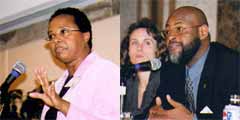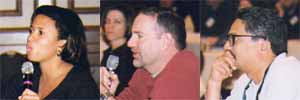Spring 2002
We Know What They Want
San Jose Mercury News Editor David Yarnold addressed more than 100 participants in San Francisco on Jan. 11 at the Pew/Maynard workshop, “Community Media Connections.” Some highlights:
 Happy New Year and welcome to the second largest city in the Bay Area. I’d like to show you how the Mercury News began the new year. It’s our front page from January 2 and the centerpiece is about the first babies of 2002 born in Silicon Valley hospitals.
Happy New Year and welcome to the second largest city in the Bay Area. I’d like to show you how the Mercury News began the new year. It’s our front page from January 2 and the centerpiece is about the first babies of 2002 born in Silicon Valley hospitals.
The stars of this show are Julie Vu and Joseph Castro, born one second apart to unwed, working mothers in Santa Clara County. We also wrote about the first births of the new year at four other area hospitals. The Aguilars and the McCulloughs hadn’t picked names for their babies at that point. But we did learn about Ares Farzad Malek, and Medha Upadhyay, whose mother’s name is Lovely Choubyay.
These babies are the vanguard of the new Silicon Valley. They’re why we’ve chosen to bet our connection with our community on the coverage of two stories: the changing demographics of our region and the impact of the technology created here. Together, those stories comprise … our community’s master narrative …
We all need to heed the words of Bob Maynard. In 1979, he wrote that a newspaper should be “an instrument of community understanding.” That begins with the recognition that, first, we have to demonstrate our understanding of our richly varied community. Too often, we view diversity as something we discover in our cities and towns – and then we report about it as outsiders. Instead, consider this proposition: Reflecting diversity is as much about what we bring to the community as what we take away from covering it.
Are we bringing an unmistakable passion for the richness of life around us? Are we opportunistic storytellers? Do we crave the authenticity that seeing the whole community brings to our news reports? Do we understand that diversity isn’t just a business proposition, but that it can make us more confident in the quality of our journalism? Do we take seriously our obligation to record history’s first draft for the whole community? Do we demonstrate a healthy curiosity about multi-hued traditions and values?
Can our news reports be joyful, celebrating the things that bring our varied readers pleasure – family, romance, rites of passage? To be sure, there are poor and disempowered who need our help. There are the ill and infirmed whose stories need to be told. But most of the time, for most of our readers, children and grandchildren bring joy, holidays unite us – and terrorism reminds us that America was built by immigrants.
Do we willingly bring an understanding of all of that to our daily reports? Or do we slip, benumbed, into the conflict model of storytelling and follow tired, traditional news judgment blissfully into irrelevancy?
Do we focus on civic solutions or slink down from the hills to shoot the wounded? The agenda for this program is ripe with the opportunity to broaden our view of news, from telling untold stories to understanding what readers want. Frankly, I think we know what they want. They want a lot of what we already give them: hard news, investigations, information about schools and health. But they want news to be told through people and they want to see people like themselves in our reports. They want a reason to hope. They want to see their successes reflected in our work as well as their tribulations.
Credibility and Coverage
Hell, we know what they want. Either we don’t know how to give it to them or we don’t want to give it to them.
Can we build on the good work of the Pew Center “to create and refine better ways of reporting the news to re-engage people in public life?”… After 25 years in journalism, I believe this as deeply as anything I know: To the extent that people see their communities represented in our papers, they view us as credible. Credibility and coverage are inextricably linked – and therefore vital to our future as conveners of community and as viable businesses.
… Tonight, we’re going to explore what “Connecting With Community” means at the Mercury News. We are far from perfect. In fact, we can’t even see the finish line. But it’s the only paper I can talk about authoritatively.
This is our mission statement, which appears every day at the top of Page 2. It says:
We are passionate about serving readers in Silicon Valley and its global electronic community, reporting and writing accurately and fairly, shining a light on injustice and defending the public’s right to know.
We will reflect the changing demographics of the community in both coverage and hiring, recognizing that diversity is a core component of accuracy.
Two stories are central to our mission: the impact of technology and the changing demographic landscape of America. These two stories create powerful connections between our community and others, both domestic and international.
That mission statement – which reflects our core values – drives our coverage goals, which drive our structure, which determines our decision-making. We turn to these values when delivering evaluations and determining who our top performers are. And I can tell you, in tough economic times, it’s essential to have these values to guide us. Here’s an example: Despite reducing staff by more than 40 people, our five-person race and demographics team has remained fully staffed throughout.
Let’s take a look at some of our diversity coverage. When the U.S. Census Bureau released its California data, our lead detailed how a surge in California’s Latino and Asian populations, combined with an unexpectedly large drop in the white population, had turned California into the nation’s most diverse state. A sidebar on state growth seized on a fact that other papers missed: For the first time, a majority of Californians live outside the Bay Area and Los Angeles … We also zeroed in on the Asian boom.
Even as the Bay Area grows more diverse, a growing number of Latinos and Asians are living in places where they make up more than 70 percent of the population. To examine this pattern, we profiled two Union City neighborhoods. On this day, we wrote about Decoto, an 80 percent Latino enclave that wears its ethnic identity with pride. The following day, we wrote about an affluent new subdivision, 75 percent Asian.
But there is tension in the new California. This centerpiece tells of a group of parents who want to secede from a local school district and create their own. But the new district – filled with affluent, highly educated, ambitious families – would be more than 60 percent Asian. It would be what some educators call a racially segregated enclave of privilege.
Bursting the Dot-Com Bubble
… I want to be clear when I talk about technology coverage. It’s not our job to celebrate technology, but rather, to elevate it as a coverage topic.
In covering the bursting of the dot-com bubble, we did a thoroughly unflattering post-mortem on Pets.com. We used the online pet industry as the vehicle for that examination, since it provided a textbook example of the giddiness that drove the dot-com boom to bust. What were we thinking? Why did we ever think it was necessary to have three national sites to buy Puppy Chow on line?
After years of sizzling growth, Cisco Systems, the region’s largest corporate employer announced in March that 8,000 people would lose their jobs. … In order to explain the food chain that Cisco sits atop, it was important to explain how the fortunes of smaller companies were directly tied to Cisco’s success. We devoted the back page one Sunday to a graphic that showed how low demand for delivering high-speed Internet connections to homes and offices contributed to Silicon Valley’s economic downturn. It bankrupted the big-name ISPs and trickled all the way down to Vietnamese immigrants who assemble circuit boards.
Before “Shrek” opened, one of our film reviewers looked into the technology used by animators to create the lifelike characters … This is a good example of how covering our master narrative is not just the responsibility of one department.
… I think diversity and technology intersect at ambition. Let me show you how: In less than a decade, a cluster of modest suburbs has become a land of stark contrasts, and the gulf has widened between the comfortable and those who serve them.
In “A Valley Family’s Supporting Cast,” we described one high-tech family’s support network. We met the pool cleaner, salon owner, gardener, speech therapist, preschool teacher, grocery clerk and dry cleaner. These uncelebrated workers get by with few resources beyond their time, their energy and their willingness to sacrifice. What drives them? The same ambition that drives the technology class.
… Where is the Mercury News headed? Pardon me if I can’t stand the thought of another incremental step along the road to covering a diverse community. I want to see the status quo in my rear-view mirror. I want each of our newsroom professionals to bring to bear their life experiences in all of their work.
For Yarnold’s entire address, click on: www.pewcenter.org/doingcj/speeches/s_yarnold.html.

KNBC’s Paula Madison and the Detroit Free Press’ John X. Miller

San Francisco workshop participants talk and listen.
